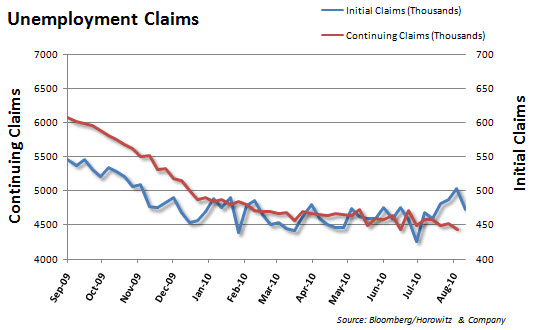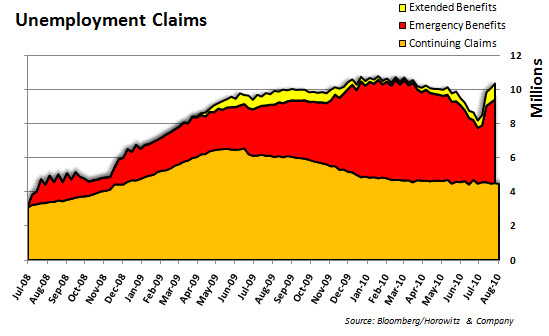Another week, another weak employment number. That is on top of a weak durable number and dreadful housing reports. There is clearly a dearth of desire for companies to begin hiring programs as there is such a general sense of uncertainty that has permeated individuals and companies.
These are the times that we need to worry about the most as consumers have companies (through capital expenditures) and consumers (through general spending) could put a quick stop to any spending.
Yet, once again headlines promoted the idea that continuing claims are slowly coming down. We are here to say, once again that this is just plain wrong. Of course if you choose to look at only part of the picture, then that is fine. But perhaps a look at the chart below will provide clear evidence that there is a rise that needs to be included from the extended and emergency claims.
The bottom line is that claims are claims. The government should adjust the “official” continuing claims to include ALL claims. But they won’t as they know how terrible that will look.
Jeff Rosen had a great commentary of this…
A breakout from the ongoing stagnation in the labor market remains elusive as the initial claims level fell during the week, but remained firmly grounded between 450,000 and 500,000 claimants as it has done just about every week since the middle of November 2009.
There has been nothing to suggest that the claims level will suddenly strengthen and fall below the lower bound any time soon. In last week‘s Data Detail, we mentioned that the declines in temporary census worker payrolls could have masked a drop in private sector firings. We used that analysis to suggest that the rise back up to the 500,000 upper bound was temporary and we expected claims to fall below 450,000 as soon as census worker employment stabilized.
Unfortunately, the removal of temporary census workers last week was not the cause of the heightened initial claims level. For the first time since the week ending July 17, net census payrolls increased during the week. This means the contribution from census workers to the initial claims level was minimal, and private firings remain at a heightened level.
The Department of Labor confirmed these findings by issuing a statement this week saying there were no unusual factors that caused last week‘s claims level to rise to 500,000.
Looking at this week‘s data, unless there was an unexpected influx of census workers, the private sector again provided the bulk of the newly laid-off workers. Even with the overall decline, these numbers suggest that our early projections of a 50,000 gain in nonfarm payrolls in August are probably too high and we may see payroll growth closer to zero.
___
In last week‘s Data Detail, we mentioned that the declines in temporary census worker payrolls could have masked a drop in private sector firings. We used that analysis to suggest that the rise back up to the 500,000 upper bound was temporary and we expected claims to fall below 450,000 as soon as census worker employment stabilized.
Unfortunately, the removal of temporary census workers last week was not the cause of the heightened initial claims level. For the first time since the week ending July 17, net census payrolls increased during the week. This means the contribution from census workers to the initial claims level was minimal, and private firings remain at a heightened level.
The Department of Labor confirmed these findings by issuing a statement this week saying there were no unusual factors that caused last week‘s claims level to rise to 500,000.
Looking at this week‘s data, unless there was an unexpected influx of census workers, the private sector again provided the bulk of the newly laid-off workers. Even with the overall decline, these numbers suggest that our early projections of a 50,000 gain in nonfarm payrolls in August are probably too high and we may see payroll growth closer to zero.A breakout from the ongoing stagnation in the labor market remains elusive as the initial claims level fell during the week, but remained firmly grounded between 450,000 and 500,000 claimants as it has done just about every week since the middle of November 2009. There has been nothing to suggest that the claims level will suddenly strengthen and fall below the lower bound any time soon.
In last week‘s Data Detail, we mentioned that the declines in temporary census worker payrolls could have masked a drop in private sector firings. We used that analysis to suggest that the rise back up to the 500,000 upper bound was temporary and we expected claims to fall below 450,000 as soon as census worker employment stabilized.
Unfortunately, the removal of temporary census workers last week was not the cause of the heightened initial claims level. For the first time since the week ending July 17, net census payrolls increased during the week. This means the contribution from census workers to the initial claims level was minimal, and private firings remain at a heightened level.
The Department of Labor confirmed these findings by issuing a statement this week saying there were no unusual factors that caused last week‘s claims level to rise to 500,000.
Looking at this week‘s data, unless there was an unexpected influx of census workers, the private sector again provided the bulk of the newly laid-off workers. Even with the overall decline, these numbers suggest that our early projections of a 50,000 gain in nonfarm payrolls in August are probably too high and we may see payroll growth closer to zero.


















